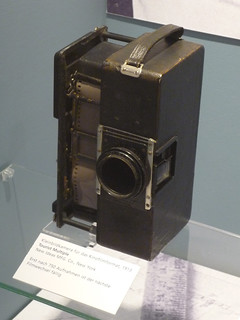Difference between revisions of "Tourist Multiple"
Danipuntocom (talk | contribs) (added image) |
Hanskerensky (talk | contribs) (Added link to review) |
||
| (One intermediate revision by the same user not shown) | |||
| Line 7: | Line 7: | ||
|image_rights=nc | |image_rights=nc | ||
}} | }} | ||
| + | The history of the 35mm [[half-frame]] cameras began in 1913 with a "full-frame" camera. That's because the [[35mm film]] camera '''Tourist Multiple''' delivered the ''full'' 18×24mm [[35mm]] cine-film movie frame format. It was made by Herbert & Huesgen, New York. 12 years later this "full-frame" cine format became the [[half-frame]] still camera format because the [[Leica A|Leica Ia]] became a huge success, defining 24×36mm as standard for [[miniature]] still cameras. | ||
| − | + | ==Links== | |
| + | *[https://mikeeckman.com/2019/05/kepplers-vault-38-herbert-huesgen-tourist-multiple/ Tourist Multiple review] at [https://mikeeckman.com/ Mike Eckman Dot Com] | ||
[[Category:half frame]] | [[Category:half frame]] | ||
[[Category:1911-1914]] | [[Category:1911-1914]] | ||
[[Category:USA]] | [[Category:USA]] | ||
| + | [[Category:T]] | ||
Latest revision as of 04:19, 21 February 2024

|
| Tourist Multiple (1913) Deutsches Technikmuseum Berlin image by Danipuntocom (Image rights) |
The history of the 35mm half-frame cameras began in 1913 with a "full-frame" camera. That's because the 35mm film camera Tourist Multiple delivered the full 18×24mm 35mm cine-film movie frame format. It was made by Herbert & Huesgen, New York. 12 years later this "full-frame" cine format became the half-frame still camera format because the Leica Ia became a huge success, defining 24×36mm as standard for miniature still cameras.